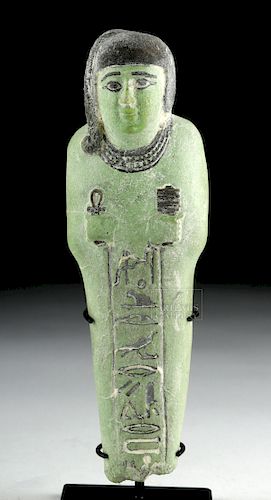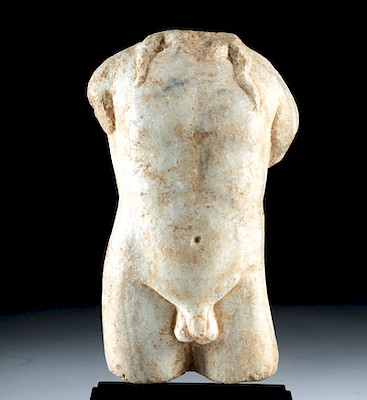Egyptian Faience Ushabti of Hori - TL Tested
Lot 2
About Seller
Artemis Fine Arts
686 S Taylor Ave, Ste 106
Louisville, CO 80027
United States
Selling antiquities, ancient and ethnographic art online since 1993, Artemis Gallery specializes in Classical Antiquities (Egyptian, Greek, Roman, Near Eastern), Asian, Pre-Columbian, African / Tribal / Oceanographic art. Our extensive inventory includes pottery, stone, metal, wood, glass and textil...Read more
Estimate:
$4,000 - $6,000
Absentee vs Live bid
Two ways to bid:
- Leave a max absentee bid and the platform will bid on your behalf up to your maximum bid during the live auction.
- Bid live during the auction and your bids will be submitted real-time to the auctioneer.
Bid Increments
| Price | Bid Increment |
|---|---|
| $0 | $25 |
| $300 | $50 |
| $1,000 | $100 |
| $2,000 | $250 |
| $5,000 | $500 |
| $10,000 | $1,000 |
| $20,000 | $2,500 |
| $50,000 | $5,000 |
| $100,000 | $10,000 |
| $200,000 | $20,000 |
About Auction
By Artemis Fine Arts
Dec 5, 2018
Set Reminder
2018-12-05 10:00:00
2018-12-05 10:00:00
America/New_York
Bidsquare
Bidsquare : DAY 1 | Classical Antiquities & Asian Art
https://www.bidsquare.com/auctions/artemis-gallery/day-1-classical-antiquities-asian-art-3698
Day 1 of an important 2-day auction featuring ancient and ethnographic art from around the world. Egyptian, Greek, Roman, Viking, Near Eastern plus Asian Art from China, Japan, Thailand, Vietnam, Burma, India, more. Artemis Fine Arts info@artemisfinearts.com
Day 1 of an important 2-day auction featuring ancient and ethnographic art from around the world. Egyptian, Greek, Roman, Viking, Near Eastern plus Asian Art from China, Japan, Thailand, Vietnam, Burma, India, more. Artemis Fine Arts info@artemisfinearts.com
- Lot Description
Ancient Egypt, New Kingdom, Ramesside, Dynasty 19 to 20, ca. 1295 to 1070 BCE. A pale green and black faience ushabti of Hori. He is a mummiform figure wearing a large collar, holding an ankh and a djed pillar, one in each of his crossed hands at his chest. He wears a large black wig with a sidelock. Below the hands is a long panel of hieroglyphs, nicely incised and painted to stand out clearly. This ushabti may be from Hori (the heiroglyph for his name is partial) and is dedicated to Osiris. During the Ramesside period, ushabtis were deposited into ceramic jars with lids shaped like the heads of the four sons of Horus. Size: 1.75" W x 6" H (4.4 cm x 15.2 cm); 6.2" H (15.7 cm) on included custom stand.
Ushabti (or shabti) dolls are figures shaped like adult male or female mummies wearing traditional ancient Egyptian headdresses. The ancient Egyptians believed that after they died, their spirits would have to work in the "Field of Reeds" owned by the god of the underworld, Osiris. This meant doing agricultural labor - and it was required by all members of society, from workers to pharaohs. The wealthier nobility in Egyptian society were able to have shabtis made of faience; its color was meant to reflect the color of the river Nile both on earth and in the afterlife.
This piece has been tested using thermoluminescence (TL) and has been found to be ancient and of the period stated. A full report will accompany purchase.
Provenance: private A.G. collection, Chicago, Illinois, USA
All items legal to buy/sell under U.S. Statute covering cultural patrimony Code 2600, CHAPTER 14, and are guaranteed to be as described or your money back.
A Certificate of Authenticity will accompany all winning bids.
We ship worldwide and handle all shipping in-house for your convenience.
#128468Feet are lost. Otherwise in good condition, with mostly clear and readable hieroglyphs. Light deposits, mainly in lower profile areas. TL sample taken from base. Signs of wear commensurate with age.Condition
- Shipping Info
-
All shipping is handled in-house for your convenience. Your invoice from Artemis Gallery will include shipping calculation instructions. If in doubt, please inquire BEFORE bidding for estimated shipping costs for individual items.
-
- Buyer's Premium



 EUR
EUR CAD
CAD AUD
AUD GBP
GBP MXN
MXN HKD
HKD CNY
CNY MYR
MYR SEK
SEK SGD
SGD CHF
CHF THB
THB














